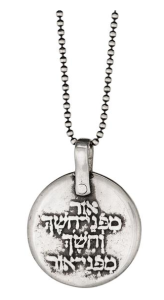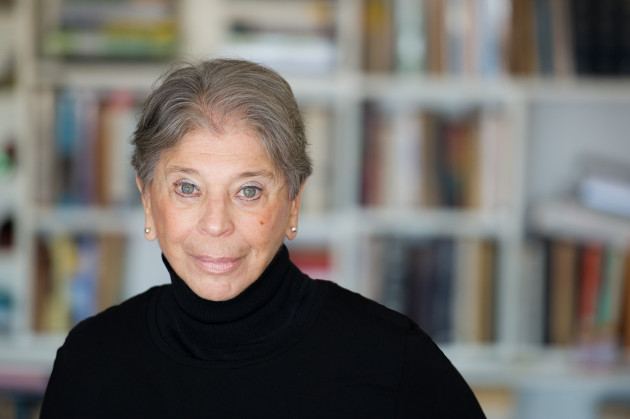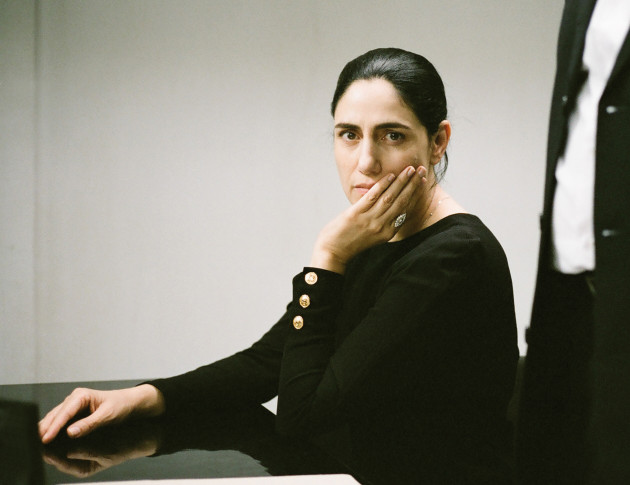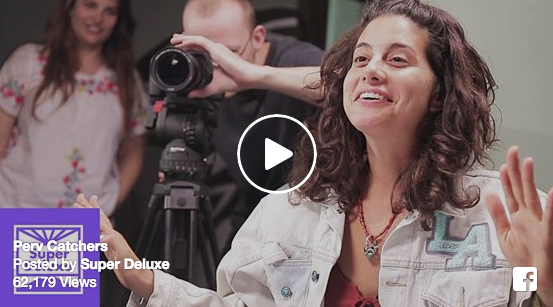The Lilith Blog
June 28, 2016 by Ariel Censor
Policing Girls’ Bodies Part One: Bras

Flickr.com, Caitlin Regan.
I started wearing bras in seventh grade. I didn’t really need to—I was something like a 32AA—but it felt like at age 13, it was time. I remember how mature and grown up I felt walking down the bra aisle of Target with my mom, selecting the brightest, most ornately patterned bras I could find in my tiny size. She couldn’t understand my fascination with what she often called “boob prisons,” but bought me three. Come the spring, I would often wear shirts that exposed my tiny, 13 year old shoulders as well as (gasp) my hot pink bra straps. I wasn’t purposefully trying to show this new sign of womanhood off (okay, maybe a little), but I didn’t really understand that bra straps were something to be hidden until my Latin teacher held me after class one day.
“Ariel,” she said, “Your bra straps have been showing all class.” She looked at me expectantly. I gave her a blank look.
“Do you have anything you could change into? Maybe a sweater or something?”
I didn’t. She handed me a bright yellow piece of paper with “Dress Code Ticket” written in Comic Sans at the top and I went to the front office, where I was presented with a giant, purple shirt, what the lady at the office called the “disciplinary shirt” and what everyone else referred to as the “shirt of shame.” Throughout the rest of the day, when my classmates asked why I was wearing a shirt that went down to my knees I had to explain to them that my bra straps were distracting to other students. More distracting than an enormous purple shirt, apparently.
- No Comments
June 27, 2016 by Amelia Dornbush
Why I Hate the Phrase “Jew by Choice”
“You aren’t really a convert, though.”
I have heard these words numerous times. Usually from friends trying to exclude me from whatever comment they are about to make about converts. Instead of making me uncomfortable, these moments remind me of the varied ways there are to be Jewish.
My Jewish journey isn’t typical—but whose is? My Dad began his conversion to Judaism when I was thirteen, and my Mom followed shortly after, saying she felt like she had discovered that she had always been Jewish late in life. Dad was of Jewish descent on his father’s side, and conversion was like coming home for him.
I spent my adolescent years rebelling against Judaism. Mom forced me to come downstairs on Friday night for our new family tradition—my parents saying Shabbat prayers while I pointedly remained silent. For me, religion was a disingenuous way to make the world easier.
When I started college, Dad persuaded me to go to Hillel for the free food. “Do you really think I’d sell out my principles for free food?” I asked when he first suggested the idea. “Your principles are free food,” he countered.
Feeling like he had a point, I went.
- 2 Comments
June 24, 2016 by Talia Liben Yarmush
Superstition, Infertility and Healing at the Mikveh
 I’m not superstitious. I’ve never knocked on wood with sincerity, I don’t avoid walking beneath ladders, and my only concerns about black cats are allergy-related. And yet, there I stood, an hour from home, inspecting myself in a bathroom. I slipped the pants off my waist and they dropped into a pile onto the floor. I lifted my shirt over my head, folded it, and placed it neatly on the counter. I stared at my naked body in the mirror: my bloated belly covered in blue and purple bruises bleeding one to the next, as though painted in water colors; injection tracks up and down both arms. I turned my attention to the list written on laminated cardstock next to the sink.
I’m not superstitious. I’ve never knocked on wood with sincerity, I don’t avoid walking beneath ladders, and my only concerns about black cats are allergy-related. And yet, there I stood, an hour from home, inspecting myself in a bathroom. I slipped the pants off my waist and they dropped into a pile onto the floor. I lifted my shirt over my head, folded it, and placed it neatly on the counter. I stared at my naked body in the mirror: my bloated belly covered in blue and purple bruises bleeding one to the next, as though painted in water colors; injection tracks up and down both arms. I turned my attention to the list written on laminated cardstock next to the sink.
Remove all barriers on your body.
Slowly, I ripped the bandaids off my belly, arms, and lower back, adding blotches of pink and red to the color palette on my body.
Remove nail polish. Clip nails.
Lifting my hands out in front of me, I inspected them closely. Engulfed in a flood of anxiety, I had already gnawed the whites off of each nail. There was a time when I had beautifully manicured nails. On my wedding day I had French tips.
- No Comments
June 22, 2016 by Pamela Rafalow Grossman
What Six Words on a Necklace Meant During My Recovery from Breast Cancer
It was the beginning of 2009. I had recently finished active treatment for breast cancer; I had also recently reconnected with a dear friend from college, Marla Wallerstein.
Marla went to the art school of our university and was known for her combination of beauty, humor, and creativity, in everything from her class assignments to her outfits to her presence as a friend. It made sense to find that she’d begun making gorgeous jewelry. She chose as part of her work’s mission to update traditional Jewish-themed pieces (large chai necklaces and the like). She jokes that she decided to take on this task “because someone has to”—but in all seriousness, the objects she creates based around Jewish texts and Jewish faith are quite stunning.
“I design, cut, hammer, rivet, etch, and solder to create each piece,” she explains on her website. “More than a labor, it’s love.”
Marla chooses for these pieces Hebrew words or parts of prayers that particularly resonate with her. “With all your heart soul might” is etched on a necklace (English on one side, Hebrew on the other). “Where you go, I will go.” “Faith.” “Shemah.”
 Though not surprised by the quality of Marla’s work when I saw it in photos, I was quite surprised when one of her creations arrived at my door, from her studio in Chicago, soon after we’d re-found each other. It’s a round silver pendant on a silver chain. Again in Hebrew and in English, it bears the etched inscription, “Light before darkness, darkness before light”—part of a text referring to the beginnings of the world: “He createth day and night, causing the light to recede before darkness and darkness before light.”
Though not surprised by the quality of Marla’s work when I saw it in photos, I was quite surprised when one of her creations arrived at my door, from her studio in Chicago, soon after we’d re-found each other. It’s a round silver pendant on a silver chain. Again in Hebrew and in English, it bears the etched inscription, “Light before darkness, darkness before light”—part of a text referring to the beginnings of the world: “He createth day and night, causing the light to recede before darkness and darkness before light.”
Marla was telling me that after the darkness of the diagnosis and treatment would come light again; and she was right. In fact, I would realize later, the seeds of the coming light had been planted during the darkest times.
- 1 Comment
June 20, 2016 by Eleanor J. Bader
Vivian Gornick on Feminism, Friendship, Gentrification, and Our Mothers

Vivian Gornick. Photo by Mitchell Bach.
“I’ve always felt like an outsider,” three-time National Book Award nominee Vivian Gornick confesses. “I used to have a dream, a bad dream, in which I was in a strange building. When I walked through the door I saw that the entire inside had been scooped out and I had to climb a rope to get to the top floor. Once there I found myself in the Bronx apartment I had grown up in. In the dream I asked myself how I’d gotten there. It was both dramatic and horrible.”
It’s a startlingly honest, if jarring, revelation, for despite the 81-year-old writer’s considerable literary success—and an output that includes dozens of articles and 12 highly-lauded books—Gornick seems genuinely shocked, perhaps even bewildered, by the esteem in which she is held. Throughout our 90-minute conversation—in one of the few diners left in Manhattan—she is warm, thoughtful, witty, and open. Our conversation is sprawling, not only touching upon the recent paperback release of her 2015 book, The Odd Woman and the City, but addressing feminism, Hillary Clinton, friendship, gentrification, walking, teaching and our mothers.
- No Comments
June 15, 2016 by Leeron Hoory
Rebecca Schiff Talks Technology and Illness, Volunteering to Be Objectified, and Writing What You Wouldn’t Say in Polite Company
 The Bed Moved is Rebecca Schiff’s debut collection of 23 short stories ranging from a few pages to a few paragraphs. Their language and voice are unique; sentences often end in ways that twist their beginnings. In “My Allergies Will Charm You,” the narrator opens with, “He had found me on the internet, and now I was going back to the internet.”
The Bed Moved is Rebecca Schiff’s debut collection of 23 short stories ranging from a few pages to a few paragraphs. Their language and voice are unique; sentences often end in ways that twist their beginnings. In “My Allergies Will Charm You,” the narrator opens with, “He had found me on the internet, and now I was going back to the internet.”
In “Communication Arts,” a teacher corresponds with students A, B, D, and Z, portraying a delicate and bizarre relationship between authority and vulnerability. Many of the characters make statements that are bleak in their honesty, revealing unintentional vulnerability. In “Third Person,” a few paragraphs paint a woman’s intricate but dissociated relationship to sex and connection: “Rebecca wanted to tell them not to worry, she forgot all the sex she had as soon as she had it, she didn’t really have it when she had it, and she hadn’t for a long time.”
The New York Times Book Review commented on Schiff’s compact language, noting her “almost Nabokovian boldness and crispness of phrase. Nabokov summarized a death in two words: ‘picnic, lightening.’ Ms. Schiff condenses a woman’s college years: ‘Nietzsche, penetration’.”
Often the characters are unintentionally funny. Many deal with illness and death. I met with Schiff in Crown Heights, Brooklyn, to speak about her book, the relationship between technology and illness, and the role humor can play when women write about difficult topics.
- 1 Comment
June 14, 2016 by Sara Luria
Brock Turner, Donald Trump, Omar Mateen: Our Deepest Spiritual Challenges

Flickr.com, Karl Schneider
A slap on the wrist for a convicted rapist caught in the act. A presidential candidate who campaigns on anger, fear, misogyny, and building walls. A gunman who joins the ranks of the countless gunmen before him by mowing down civilians with weapons designed for a war zone.
These stories filling our facebook feeds are emblematic of our political, economic, and social struggles. Yet, at their core, they demonstrate the deepest spiritual challenges we face today.
Hate is a spiritual challenge.
Treating others as less than human is a spiritual challenge.
Defensiveness is a spiritual challenge.
The beautiful, prayer-filled vigils that have been organized in the aftermath of recent tragedies are absolutely necessary for our collective mourning—but they are a downstream spiritual solution. I am tired—we are bone-crushingly tired—of gathering together and weeping over the bodies of raped women and murdered innocents.
- No Comments
June 2, 2016 by Amy Stone
Shiva for Film Force Ronit Elkabetz

Ronit Elkabetz, Israeli film star, writer and director in her last film, “Gett: The Trial of Viviane Amsalem.”
Ronit Elkabetz is gone.
The Israeli film star, writer and director is dead at 51, from cancer that she concealed till the end. Following her death on April 19, her body lay in state at the Tel Aviv Cinamatheque, showcase for independent and controversial film.
In what turned out to be her final film, just last year Americans saw Elkabetz as the long-suffering wife in “Gett: The Trial of Viviane Amsalem.” The grinding depiction of a woman’s years’ long struggle against her unyielding husband and an Israeli religious court to grant her a gett, a writ of divorce, was the final film in the trilogy starring Elkabetz as Viviane Amsalem. Loosely based on the unhappy marriage of her Moroccan-born parents, Elkabetz co-wrote and co-directed the trilogy with her brother Shlomi, starting with “To Take a Wife” in 2004, then “Shiva” in 2008. The sister-brother collaboration was intense. As she described writing “Gett,” they’d hole up in a hotel room, cut off from the world, and create the film. On the set, they were in total sync.
“Gett,” Israel’s 2015 Oscar entry for best foreign-language film, ignited major protests in Israel, where civil marriage and divorce do not exist.
As Elkabetz told the Israeli newspaper Maariv back in 2010, “I am not here to get pleasure from acting. As much as it may sound bombastic, I would like to make a change.”
- No Comments
May 26, 2016 by Rebecca Halff
Why This Abortion Rights Tactic Is Actually Sexist
 Take a minute and Google “abortion stories.” See that? They’re everywhere. You can read 173 of them on NARAL Pro-Choice America’s website alone. “Sharing your story is a powerful way to speak out for choice,” NARAL tells women. “It can inspire another person to speak out, and it could even help pass a pro-choice bill.” This is typical of how the sharing of abortion “stories” is usually framed: as a pro-choice, pro-reproductive rights political action. Sometimes, these testimonies do serve an explicitly political purpose—as when, in February of this year, women told the Supreme Court about their abortions in an effort to convince the court to protect women’s reproductive rights. Other times, the mission of those sharing their stories is less specific, albeit just as politically and culturally important: women are aiming to achieve the destigmatization and normalization of abortion, a shift in cultural attitudes that has the potential to change policy and lives. Our Bodies, Ourselves views the sharing of abortion stories as a caring act in the spirit of women’s solidarity. “Hearing women’s stories of having an abortion can help us know what to expect and reassure us that our experiences are not unique,” OBOS’s website explains.
Take a minute and Google “abortion stories.” See that? They’re everywhere. You can read 173 of them on NARAL Pro-Choice America’s website alone. “Sharing your story is a powerful way to speak out for choice,” NARAL tells women. “It can inspire another person to speak out, and it could even help pass a pro-choice bill.” This is typical of how the sharing of abortion “stories” is usually framed: as a pro-choice, pro-reproductive rights political action. Sometimes, these testimonies do serve an explicitly political purpose—as when, in February of this year, women told the Supreme Court about their abortions in an effort to convince the court to protect women’s reproductive rights. Other times, the mission of those sharing their stories is less specific, albeit just as politically and culturally important: women are aiming to achieve the destigmatization and normalization of abortion, a shift in cultural attitudes that has the potential to change policy and lives. Our Bodies, Ourselves views the sharing of abortion stories as a caring act in the spirit of women’s solidarity. “Hearing women’s stories of having an abortion can help us know what to expect and reassure us that our experiences are not unique,” OBOS’s website explains.
Women who want to share their abortion experiences with the world—for whatever reason at all—should be able to do so without fear of being shamed and stigmatized. But please, media outlets. Stop asking for my abortion story. My medical history and reproductive health are none of your business.
All over the Internet, abortion stories are being coaxed out of—and sometimes demanded from—women. The 1 in 3 Campaign (referring to the one in three U.S. women who will have an abortion in her lifetime, according to the Guttmacher Institute) takes one of the more appropriate approaches to asking for such personal and private information by suggesting rather than demanding that women participate in the project. “The [campaign] is a grassroots movement to start a new conversation about abortion—telling our stories, on our own terms,” the website explains. Other campaigns, like #ShoutYourAbortion, are neither as diplomatic nor as respectful of a women’s right to choose—in this case, our right to choose not to share our medical history with the general public. Their verb of choice is actually in the imperative.
- 1 Comment
May 24, 2016 by Leeron Hoory
Jessie Kahnweiler Confronts Online Dating App Sexters
L.A.-based filmmaker Jessie Kahnweiler does not shy away from controversy. She has just released a new video where she confronts men who’ve sent her online sexts on Tinder. In the video she confronts these men in person—men unprepared for her experiment—to have them read their online sexts to her in person. Even they are embarrassed by their communication, and it’s clear from the exercise that the men treat women in person differently than online.
This video can be seen as a continuation of “The Skinny,” Kahnweiler’s recent dark comedy series. Produced by Jill Soloway’s Wifey.TV and Refinery29, the web series premiered at the Sundance. The episodes follow Jessie’s life as a feminist and striving YouTube star in L.A., yet the series is unsettling; it deals with the realities of battling bulimia, based Kahnweiler’s own 10-year struggle with the eating disorder.
- No Comments
 Please wait...
Please wait...
